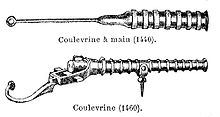- Culverin
-
A culverin was a relatively simple ancestor of the musket, and later a medieval cannon, adapted for use by the French in the 15th century, and later adapted for naval use by the English in the late 16th century. The culverin was used to bombard targets from a distance. The weapon had a relatively long barrel and a light construction. The culverin fired solid round shot projectiles with a high muzzle velocity, producing a relatively long range and flat trajectory. Round shot refers to the classic solid spherical cannonball.
Contents
Hand culverins
 "Hand bombard", or early culverin, 1390-1400.
"Hand bombard", or early culverin, 1390-1400.
The term "culverin" is derived from the Latin, colubrinus, or "of the nature of a snake". It was originally the name of a medieval ancestor of the musket, used in the 15th and 16th centuries.[1]
The hand culverin consisted in a simple smoothbore tube, closed at one end except for a small hole designed to allow ignition of the gunpowder. The tube was held in place by a wooden piece which could be held under the arm. The tube was loaded with gunpowder and lead bullets. The culverin was fired by inserting burning slow match into the hole.
These hand culverins soon evolved into heavier portable culverins, around 40 kg (88 lb) in weight, which required a swivel for support and aiming. Such culverins were further equipped with back-loading sabots to facilitate reloading, and were often used on ships.
Field culverins
There were three types of culverin in use, distinguished by their size: the culverin extraordinary, the ordinary, and the least-sized.[2]
Name Bore diameter Length Weight Shot diameter Shot weight culverin extraordinary 5½ inches (140 mm) 32 calibers (14 ft 8 in; 4.5 m) 4800 pounds (2200 kg) 5¼ inches (135 mm) 20 pounds (9.1 kg) ordinary culverin 5½ inches (140 mm) 25 calibers (12 ft; 3.6 m) 4500 pounds (2000 kg) 5½ inches (140 mm) 17 pounds 5 ounces (7.9 kg) culverin of the least size 5 inches (130 mm) 29 calibers (12 ft; 3.6 m) 4000 pounds (1800 kg) 3¼ inches 14 pounds 9 ounces (6.6 kg)  Bronze culverins and demi-cannon
Bronze culverins and demi-cannon
There were also smaller versions, including the bastard culverin (4 inches (100 mm), 7 pounds (3.1 kg) shot and the demi-culverin or culverin-moyen (4½ inches (114 mm), 10 pound (4.5 kg) shot.[1]
Overall, the culverin was a significant advance over the ballista, which was the "light artillery" unit of the previous eras. Since it fired a ball of iron and relied on gunpowder for propulsion, the heavier ball meant a more stable flight and the gunpowder propulsion meant a faster and farther-ranged weapon. A replica culverin extraordinary has achieved a muzzle velocity of 408 m/s, and a range over 450 m using only minimal elevation.[3] This velocity and mass imply that the cannonball had a kinetic energy of roughly 600 kilojoules (440,000 ft·lbf) when leaving the muzzle.
The culverin was later replaced by the field gun once technology had advanced to the point where cannonballs had become explosive.
- "Hurrah! the foes are moving. Hark to the mingled din,
- Of fife, and steed, and trump, and drum, and roaring culverin."
- Macaulay, Ivry, 31-32
- "In this, my countrymen, be rul'd by me:
- Have special care that no man sally forth
- Till you shall hear a culverin discharg'd
- By him that bears the linstock, kindled thus;
- Then issue out and come to rescue me,
- For haply I shall be in distress,
- Or you releasèd of this servitude."
- Marlowe, The Jew of Malta, Act V
References
- ^ a b "culverin". Oxford English Dictionary. Oxford University Press. 2nd ed. 1989.
- ^
 This article incorporates content from the 1728 Cyclopaedia, a publication in the public domain.
This article incorporates content from the 1728 Cyclopaedia, a publication in the public domain. - ^ Discovery Channel, Battlefield Detectives, episode "Who Sank the Armada"
External links
Weapon types Arquebus · Bâton à feu · Bombard · Crapaudin · Culverin · Fauconneau · Pot-de-fer · Perrier à boîte · Ribauldequin · VeuglaireFamous guns By country FranceRelated Categories:- Cannon
- Medieval weapons
- Renaissance-era weapons
- Muskets
Wikimedia Foundation. 2010.




